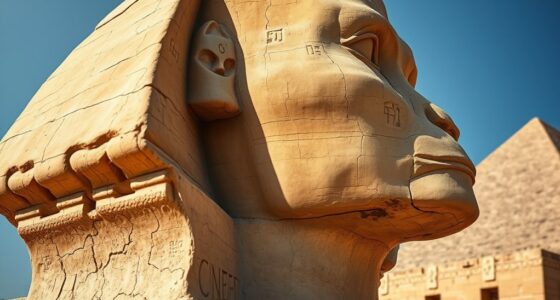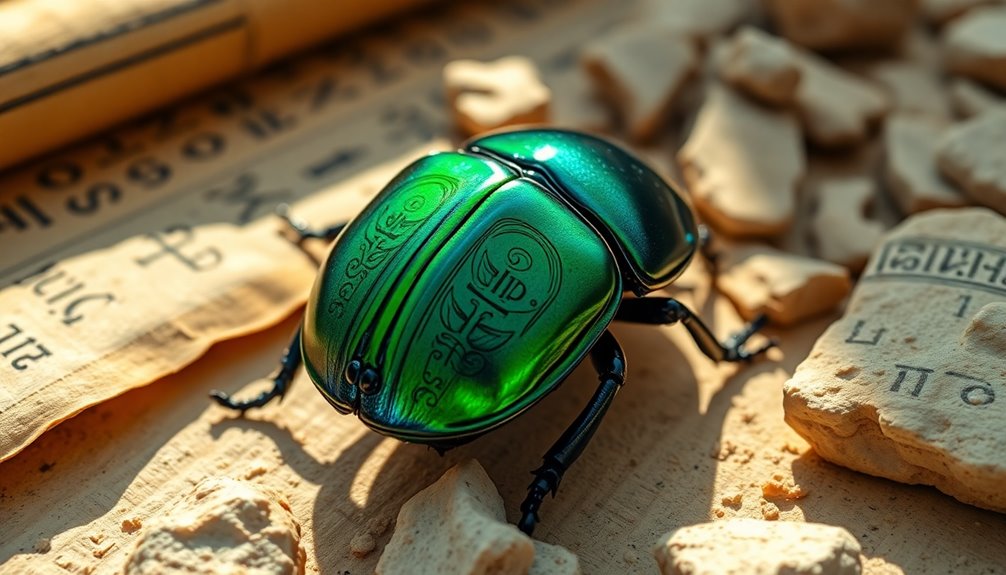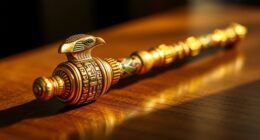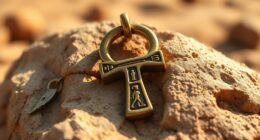The Eyes of Ra and Horus highlight a fascinating connection between healing and destruction in ancient Egyptian mythology. The Eye of Horus represents protection, wisdom, and restoration, while the Eye of Ra embodies power and fury. Together, they symbolize the balance between chaos and order, revealing the complexities of spiritual practices. By appreciating how these two symbols complement each other, you'll uncover a deeper perspective on life's dynamics. Their rich cultural significance continues to influence modern spirituality, reminding us of the ongoing interplay of strengths we face. Unraveling this duality opens new doors to understanding.
Key Takeaways
- The Eyes of Ra and Horus symbolize the duality of power and healing, reflecting essential balance in ancient Egyptian spirituality.
- The Eye of Horus represents protection and recovery, while the Eye of Ra embodies destructive power and divine retribution.
- Both eyes serve as protective amulets, showcasing their importance in safeguarding individuals from negativity and fostering well-being.
- Myths associated with these eyes illustrate contrasting themes of order and chaos, emphasizing their complementary nature in mythology.
- Understanding their symbolism can deepen spiritual insight and appreciation for ancient Egyptian culture and its enduring legacy.
Background of Egyptian Eyes
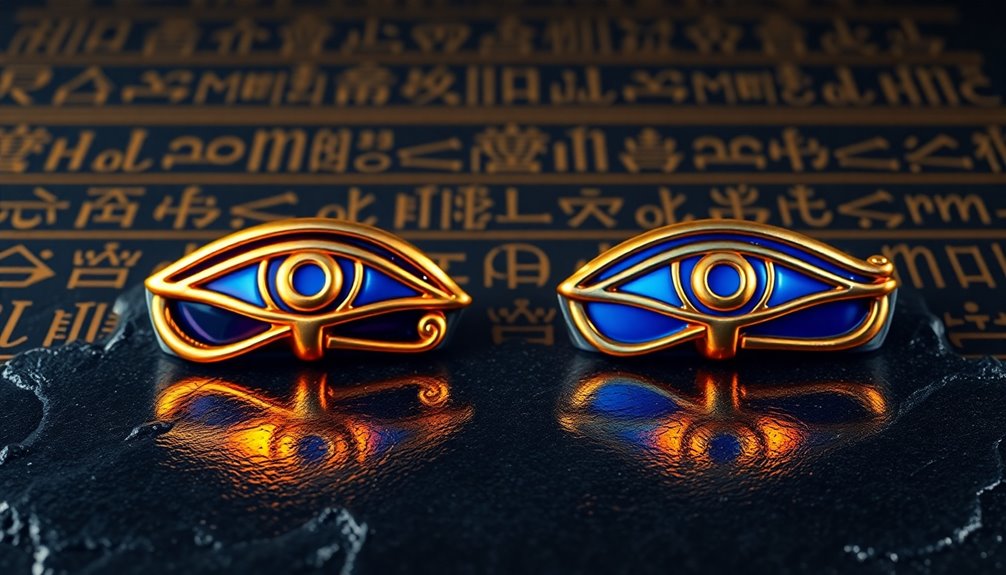
When you immerse yourself in the fascinating world of ancient Egyptian symbolism, the Eyes of Ra and Horus stand out as powerful icons. Central to Egyptian mythology, these eyes symbolize contrasting yet complementary forces.
The Eye of Horus, also known as the wedjat, embodies healing, protection, and wisdom. It's deeply tied to the myth of Horus avenging his father's death, symbolizing regeneration and spiritual safeguarding, making it a popular amulet for protection in ancient Egyptian religion.
In stark contrast, the Eye of Ra represents power, fury, and destruction, reflecting the sun's fierce nature. Often associated with Ra's vengeful daughter, it symbolizes punishment and authority, reinforcing the idea of divine retribution.
Both eyes serve as essential symbols in Egyptian culture, frequently depicted together in art and jewelry. This artistic representation emphasizes their connection to celestial bodies, showcasing the duality of life.
While the Eye of Horus represents healing and protection, the Eye of Ra embodies the sun's watchful and protective qualities. Together, they reflect the intricate balance of power and healing in ancient Egyptian beliefs, showcasing their importance in both daily life and spiritual practices.
Meaning of the Eye of Horus
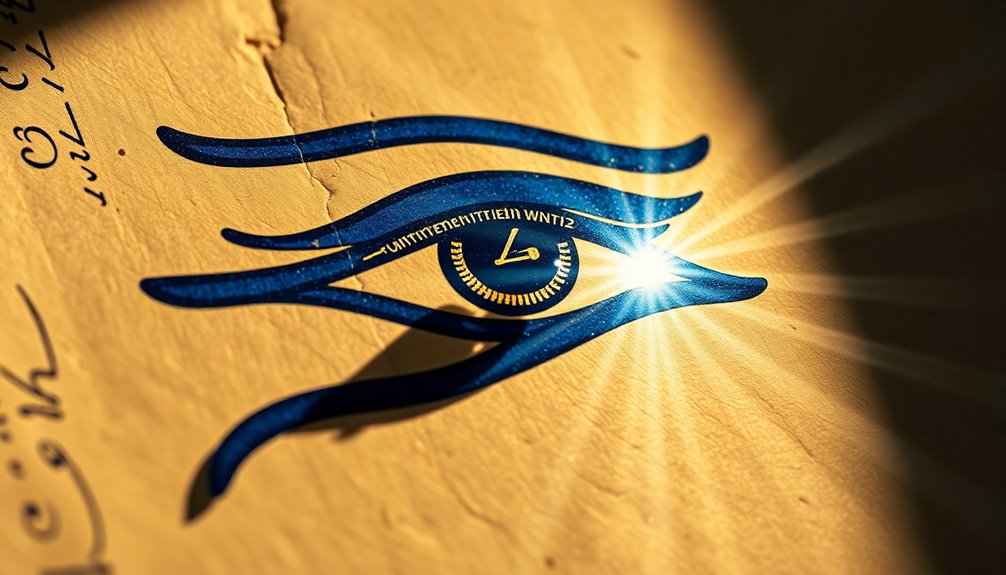
The Eye of Horus, known as the Wedjat, carries profound meaning in ancient Egyptian culture. This powerful symbol represents the left eye of the god Horus, embodying healing and protection, stemming from its legendary restoration after a fierce battle with Set. The Eye of Horus isn't just about sight; it's also an all-seeing eye, a symbol of protective power that watches over you.
Here's how the Eye of Horus reflects its significance:
| Aspect | Meaning | Symbolism |
|---|---|---|
| Healing | Represents recovery | Restoration of the eye |
| Protection | Acts as a shield for the wearer | Symbol of protection |
| Wholeness | Corresponds to the six senses | Completeness in life |
In ancient Egyptian culture, this symbol was often worn as amulets or jewelry, ensuring well-being and safety. Its falcon-like markings connect it to the sky god Horus, emphasizing the balance between chaos and order. By embracing the Eye of Horus, you tap into a legacy of resilience, wisdom, and enduring protection.
Meaning of the Eye of Ra
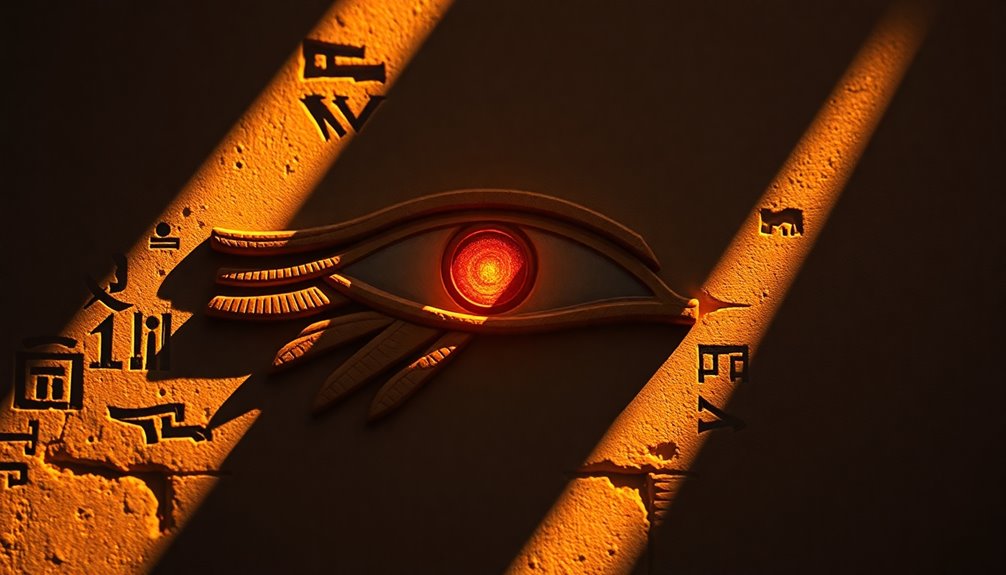
The Eye of Ra is a powerful symbol, representing the sun and the fierce protection of the god Ra.
It's intertwined with various myths, illustrating Ra's anger and his daughter's destructive force, which reflects the balance between creation and destruction.
Today, its cultural impact continues, as people use it in art and amulets for protection and to invoke divine authority.
Symbolism of Eye
Among the powerful symbols in ancient Egyptian mythology, the Eye of Ra stands out as a representation of the sun god Ra, embodying strength and protection.
This eye is more than just a symbol; it's a powerful force that conveys various meanings linked to divine authority and vengeance.
Here's what you should know about the symbolism of the Eye of Ra:
- Ra Represents the Sun: As the right eye of Ra, it signifies the life-giving and destructive power of the sun.
- Protective Amulet: The Eye of Ra is commonly used in amulets, serving to ward off negativity and protect individuals and kingdoms.
- Vengeful Aspect: Connected to Ra's daughter, who turned into the goddess Wadjet, it illustrates the sun's capacity for retribution against wrongdoers.
- Royalty and Authority: This symbol is essential in ancient Egyptian art and religious practices, representing the omnipotent nature of Ra over his followers.
Myths Surrounding Eye
In ancient Egyptian mythology, the myths surrounding the Eye of Ra reveal a complex narrative filled with themes of power and vengeance. The Eye of Ra, depicted as the right eye, symbolizes the sun and embodies the protective force of Ra, the sun god. Created by Hathor, this eye was released to punish humanity for their disrespect, showcasing its fierce authority and destructive capabilities. This act reflects the duality present in ancient Egyptian civilization, where power could be both a shield and a weapon.
Unlike the Eye of Horus, which represents healing and protection, the Eye of Ra conveys a more fearsome aspect of divine retribution. As the myths and legends unfold, you see Ra regain control over the Eye by intoxicating it, illustrating the delicate balance between power and restraint in Egyptian beliefs.
The Eye of Ra is often depicted with a cobra or teardrop, emphasizing its royal connections and divine authority. It's this blend of fear and protection that makes the Eye of Ra an essential symbol in understanding the complexities of ancient Egyptian mythology and its enduring legacy.
Cultural Impact Today
Numerous modern interpretations of the Eye of Ra showcase its enduring significance in spirituality and symbolism. This powerful symbol, linked to the sun god Ra, represents protection and divine authority, echoing its importance in ancient Egyptian culture.
Today, the Eye of Ra continues to resonate, influencing various aspects of life:
- Spiritual Practices: Many people incorporate the Eye of Ra in rituals and meditations, seeking its protective qualities.
- Art and Fashion: You'll find the Eye of Ra featured in art, jewelry, and tattoos, symbolizing strength and power.
- Cultural Symbolism: The Eye of Ra is often juxtaposed with the Eye of Horus, representing a balance between protection and authority.
- Popular Media: Films and literature frequently reference these symbols, reinforcing their significance in contemporary storytelling.
Similarities Between the Eyes

When you look at the Eyes of Ra and Horus, you'll notice they both carry immense protective powers.
Each symbol not only serves to ward off evil but also showcases significant cultural importance in ancient Egyptian art.
Their shared role in providing spiritual guidance underscores how intertwined these two symbols truly are.
Protective Powers of Both
Both the Eye of Ra and the Eye of Horus are revered for their protective powers, each offering unique strengths that safeguard individuals and the domain. In ancient Egyptian culture, these symbols served essential roles in ensuring safety and harmony, reflecting a deep understanding of the balance between chaos and order.
Here are four key protective attributes of both eyes:
- Healing and Restoration: The Eye of Horus is celebrated for its ability to promote well-being and deflect evil, making it a powerful symbol of health.
- Strength and Punishment: The Eye of Ra symbolizes divine strength, wielding punishment against enemies and safeguarding royal authority.
- Spiritual Protection: Both eyes collectively provide spiritual protection, warding off malevolent forces and ensuring peace.
- Complementary Roles: Depicted together, the Eyes of Ra and Horus emphasize their complementary nature, showcasing the necessity of both healing and power in ancient Egyptian beliefs.
In essence, these protective powers not only shield individuals but also uphold the integrity of the state, embodying a profound wisdom that continues to resonate today.
Cultural Significance in Art
In ancient Egyptian art, the Eyes of Ra and Horus frequently appear together, embodying a profound symbolism that highlights the balance between power and protection. The Eye of Ra, symbolizing the sun, exudes raw power and can represent destruction, while the Eye of Horus, associated with the moon, signifies healing and protection. This duality is vital in understanding ancient Egyptian beliefs.
Both eyes have been intricately woven into jewelry and amulets, showcasing their protective qualities. In artistic representations, you'll notice the Eye of Horus adorned with falcon-like markings, whereas the Eye of Ra often appears with a cobra or teardrop, emphasizing their unique attributes. This visual distinction not only enhances their artistic appeal but also deepens their symbolic meanings.
The interplay between these two eyes reflects an essential theme in ancient Egyptian culture—the balance between healing and destruction. As you explore ancient Egyptian art, you'll find that these symbols aren't just decorative; they convey a deeper significance, representing the combined protective powers and spiritual essence that embody the cultural heritage of ancient Egypt.
Understanding this connection can truly change your perspective on their art and beliefs.
Differences Between the Eyes
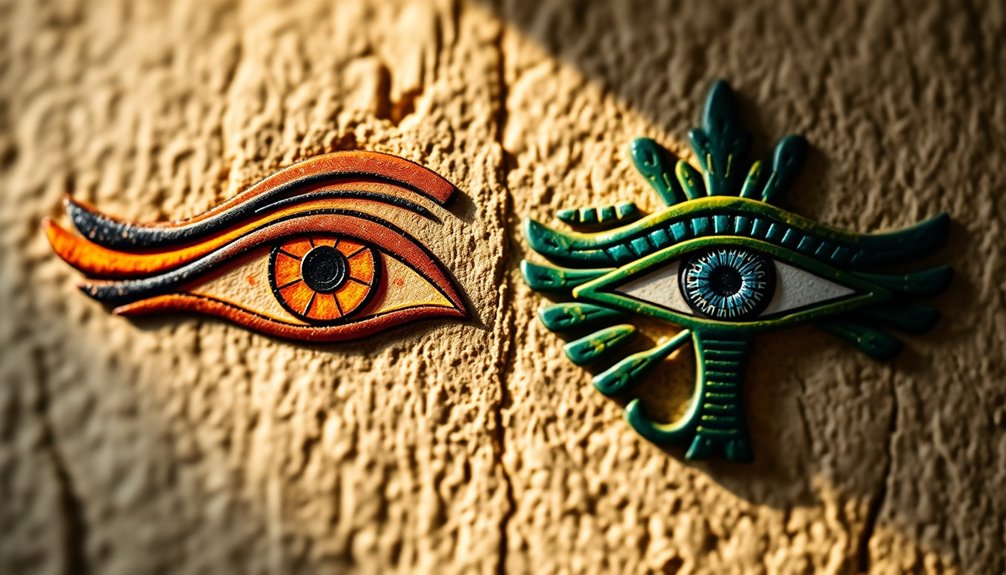
The contrasting powers of the Eyes of Ra and Horus reveal their unique roles in ancient Egyptian mythology. Each eye symbolizes distinct aspects of life and divine influence. Understanding these differences can deepen your appreciation of their significance.
- Eye of Ra: Depicted as the right eye, it embodies power, fury, and destruction. This eye is linked to the sun god Ra and often features a cobra or teardrop, representing a vengeful force that punishes those who disrespect divine authority.
- Eye of Horus: Represented as the left eye, it signifies healing, protection, and wisdom. Associated with the god Horus, it displays falcon-like markings and symbolizes restoration and balance after Horus's battle with Set.
- Chaos vs. Order: The Eye of Ra represents chaos and the potential for destruction, while the Eye of Horus stands for order and well-being.
- Cultural Usage: Although used interchangeably in ancient Egyptian art, their differing meanings highlight the ongoing conflict between chaos and order within mythology.
Cultural Significance and Myths
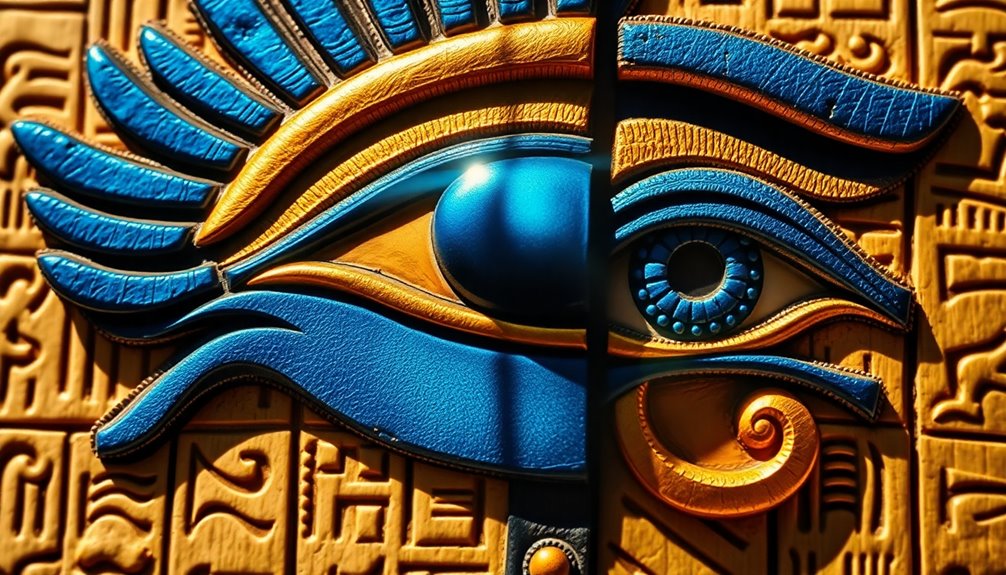
Ancient Egyptian culture is rich with symbolism, and the Eyes of Ra and Horus play essential roles in its mythology. The Eye of Horus, often depicted as the left eye, represents healing and protection. According to myths, it's linked to Horus avenging his father Osiris against Set, illustrating themes of wholeness and restoration.
In contrast, the Eye of Ra, symbolizing the destructive power of the sun, reflects Ra's authority. It's depicted as the right eye and is associated with punishment and vengeance.
These eyes embody the duality of ancient Egyptian beliefs, where the Eye of Horus offers wisdom and safeguard, while the Eye of Ra signifies a more ferocious aspect of divine power. Myths reveal how Thoth restored the Eye of Horus after its loss in battle, symbolizing regeneration and resilience.
On the other hand, the Eye of Ra serves as a reminder of the consequences of disrespecting the divine.
Both eyes were commonly featured in ancient Egyptian amulets, demonstrating their cultural significance and the importance of balancing protection with the acknowledgment of destructive power. Understanding these myths enhances your appreciation of ancient Egyptian spirituality and its profound symbolism.
Practical Applications and Symbolism
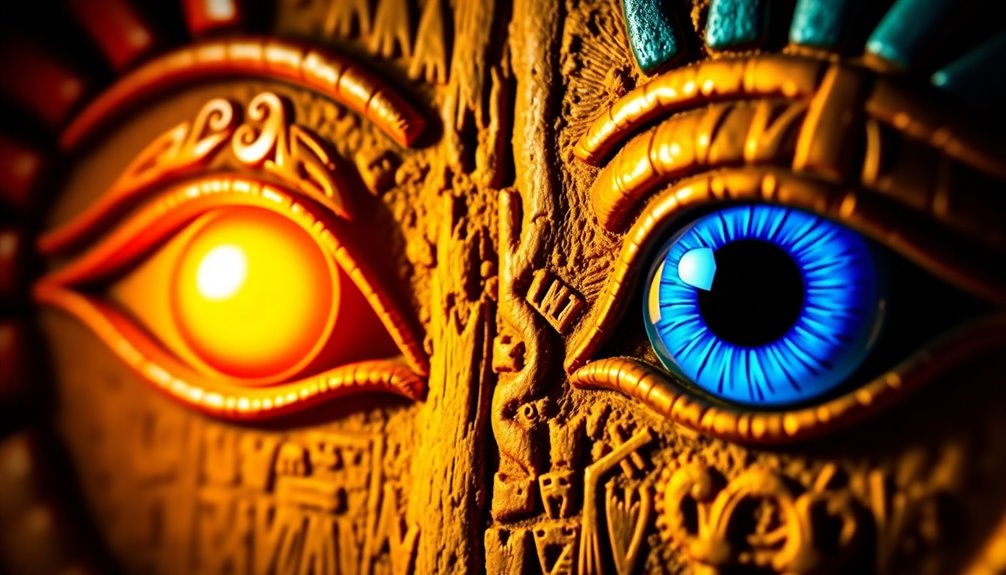
Utilizing the Eyes of Horus and Ra in various practices showcases their profound symbolism and practical applications. These ancient Egyptian symbols serve as reminders of the balance between healing and protection, making them relevant even today.
- Amulets: Wear the Eye of Horus as an amulet for personal protection and healing. This symbol's association with well-being encourages a sense of safety in your life.
- Jewelry: Incorporate the Eye of Ra in your jewelry to symbolize divine authority and ward off negativity. The red amulets representing this eye evoke the sun's protective power.
- Meditation: Use the Eyes of Horus and Ra in your meditation practices to connect with celestial bodies. Visualizing these symbols can enhance your focus on healing and restoration.
- Art: Decorate your space with artwork featuring these eyes. Their presence serves as potent emblems of protection and divine authority, enriching your environment with ancient wisdom.
Frequently Asked Questions
What Is the Connection Between Ra and Horus?
Ra and Horus are deeply connected in ancient Egyptian mythology.
You'll find that Ra, the sun god, represents authority and power, while Horus, the sky god, symbolizes kingship and protection.
As the son of Osiris and Isis, Horus is linked to Ra through this familial relationship.
Together, they embody the balance of creation and destruction, with their merged form, Ra-Horakthy, highlighting the unity of sun and sky in Egyptian cosmology.
What Is the Connection Between the Eye of Horus and the Human Brain?
The Eye of Horus connects to the human brain by symbolizing the left hemisphere's functions like logic and analytical thinking.
Each part of the Eye corresponds to sensory functions, mirroring how your brain processes information.
This duality emphasizes the need for balance between rationality and creativity.
What Does the Eye of Ra and Horus Mean?
When you gaze upon the Eye of Ra and the Eye of Horus, you're witnessing a dance of duality.
The Eye of Ra embodies fierce sunlight, a force that commands respect and authority, while the Eye of Horus whispers of healing and wisdom, guiding you toward balance.
Together, they weave a rich tapestry of ancient beliefs, reminding you that power and protection coexist, each with its own story to tell in the grand scheme of life.
What Is the Spiritual Meaning of Eye of Horus?
The Eye of Horus symbolizes healing, protection, and restoration in ancient Egyptian spirituality.
When you connect with this symbol, you tap into its essence of resilience and balance between chaos and order. Its parts reflect different senses and aspects of consciousness, promoting well-being.
Conclusion
In exploring the mesmerizing worlds of the Eye of Horus and the Eye of Ra, you've revealed ancient secrets that spark illuminated thoughts in your mind. These powerful symbols aren't just eye-catching; they're cosmic beacons, guiding you through the labyrinth of life's mysteries. Imagine harnessing their energy, transforming your perspective into a kaleidoscope of enlightenment! With every glance, you're not just witnessing history; you're dancing with the gods, forever changed by their timeless wisdom.




